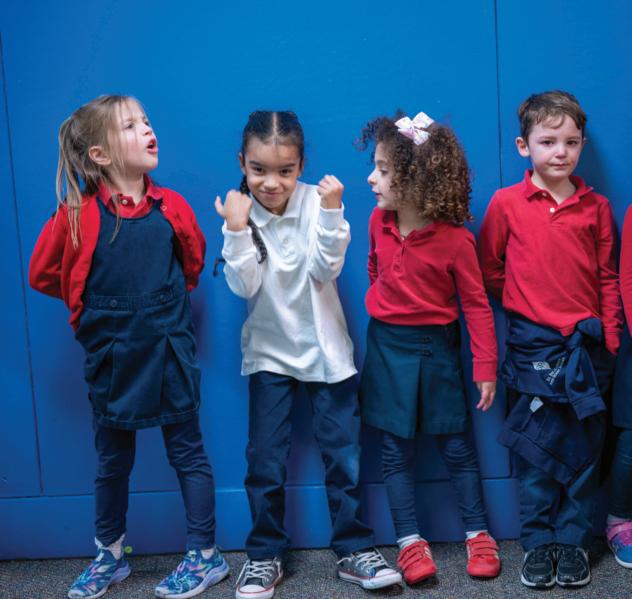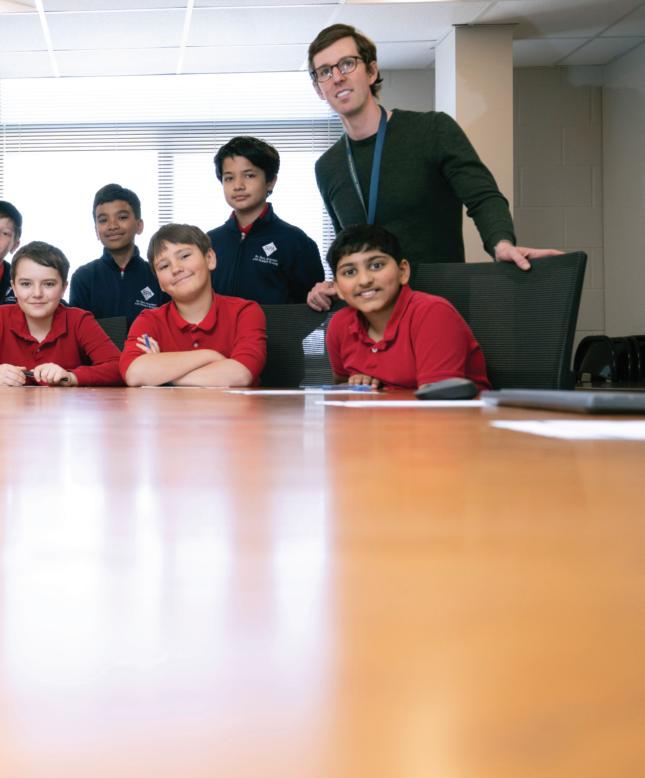
5 minute read
LOWER SCHOOL
“It
“Kids come to Kindergarten at all different stages. Some kids are still learning their letters and some are already reading chapter books. Some kids can put together two-digit numbers in their heads and others can’t accurately count to six. And that’s fine! This is a year when they’re really just learning how to do school. We want them to discover themselves, but also understand that they are part of a community. We spend a lot of time practicing our Empathy Tool, and learning that ‘everybody else in the room is just as important as I am.’
Advertisement
“A big part of Kindergarten is the kids learning to make their own decisions and getting comfortable with their own autonomy. A lot of them will spend the first few weeks not understanding how to act during our free-choice periods: they’ll look at us and ask ‘what should I do?’ And the answer is ‘Well, I’ve got good news and bad news. The good news is there are all sorts of things to do, and you can look at the list on the SmartBoard and make a choice! The bad news is that I’m not going to tell you what to do. You get to decide for yourself’.”

The Lower School uses the TOOLBOX Social Emotional Learning Curriculum to help children regulate themselves, build resilience, and restore relationships within the context of our learning community. Every Lower School faculty and staff member is trained in the TOOLBOX curriculum, which offers a common language to maximize understanding between adults and children and is based on the principle that each person has an innate capacity to seek and find solutions to regulate their own behavior, to practice empathy, kindness, and compassion and to become more and more resourceful, resilient, and confident.
The TOOLBOX is based on these 12 tools:

• Breathing Tool: I calm myself and check-in.
• Quiet/Safe Place Tool: I remember my quiet/safe place.
• Listening Tool: I listen with my ears, eyes, and heart.
• Empathy Tool: I care for others. I care for myself.
• Personal Space Tool: I have a right to my space and so do you.
• Using Our Words Tool: I use the “right” words in the “right” way.
• Garbage Can Tool: I let the little things go.
• Taking Time Tool: I take time-in and time-away.
• Please & Thank You Tool: I treat others with kindness and appreciation.
• Apology & Forgiveness Tool: I admit my mistakes and work to forgive yours.
• Patience Tool: I am strong enough to wait.
• Courage Tool: I have the courage to do the “right” thing.
“We’ve moved to a model of sports clinics in Lower School athletics instead of competitive teams. Students in grades 3-5 have seven different sports they can choose from over the course of the year, and we encourage them to try more than one sport during a season if they’re interested. It’s really the only time in a student’s athletic career that they can double up on a sport in a single season—we want to get them away from the specialization piece at a time in their lives when they’re really excited to just try anything. We’re getting a lot of participation from kids that might not be all that interested in a specific sport, but just enjoy playing with their peers during the clinics. That’s exactly what we’re after: enjoying athletics and being part of an athletic community.
“A big benefit of the Lower School clinics is the way they are increasing athletic participation once the kids get to Middle School, especially for girls. Middle School girls’ soccer and softball participation was dwindling a few years ago, but numbers have shot up since we started offering those clinics in the Lower School. And more athletic participation in Middle School is great for the entire program—we’ve started a Student Athlete Leadership group in Middle School to really start developing those kids’ leadership skills. We want to build a sense of pride and school spirit in grades 6-8 so when those kids get to the Upper School, they’re ready not just to play at that level but to lead at that level.”
DR. NAOMI TAYLOR Director of Intercultural Life
“We have had an affinity group for students of color in the Lower School for five years, but this year we expanded the program to include all students. It’s called Intercultural Club Time, and every student K-5 participates. We built the offerings around what the Lower School leadership team was hearing from students about how they wanted to engage with their peers and their interests. So we have a Common Ground group for students of color, and a Muslim identity group and a Mishpacha group [for Jewish students] and groups for kids interested in neurodiversity and LGBTQ. So the groups themselves are very diverse, but the lessons during Intercultural Club Time are all the same: there’s always a story component, a movement component, a hands-on activity, and everybody gets to share. It’s a very fun time that the kids really look forward to.
“The goal here is to normalize differences early on and in age-appropriate ways, and give students the space to share, to bring their whole selves to school, and to have a place to ask questions. Kids notice differences at a very young age, so if we can name those differences and talk about them in celebratory and affirming ways, we can put every child on a developmental arc towards positive identity development.”
“We begin referring to the kids as ‘fifth grade leaders’ very early on, and we lay out all the opportunities they’re going to have during the year to be leaders and role models for the rest of the school. Each of the opportunities has a purpose, and they all build on each other. Being an assembly emcee gives them the experience of being a public speaker; being a Kindergarten buddy gives them the experience of being a mentor and caring for a much younger child; the Principal’s Council helps them understand what it takes to work with a group to make changes. Kindergarten buddies are probably everyone’s favorite, because when the Kindergarteners see their buddy in the hallway, it’s like they’re seeing a celebrity. The kids love it.
“The kids sometimes roll their eyes and joke about being called ‘leaders’ all the time, but they really do understand what that means. They’re ready for it. They like the prestige of it, but they also understand that being a leader is also about service. And there’s some sacrifice in that—when you’re planning the Halloween assembly, you’re missing recess for two weeks, which is a big deal in fifth grade. But the end result is worth it, because the entire community is always so engaged and supportive of the kids’ efforts, and now you’ve got kids who understand that what they do matters to the entire community.”
BETH NELSON Lower School Principal
“The Grade 5 Principal’s Council is new this year. It’s part of the rotation of Grade 5 ‘jobs’ that the kids rotate through, so every fifth-grader gets to be a part of the group at some point during the year. We were looking for ways to make sure that I could have that student voice and student perspective in my ear, because our fifth-graders know a lot about how the school works.
“The group meets with me and Jake [Ban, Lower School Assistant Principal]. We meet in the conference room where the adults have their meetings, and we have an agenda and meeting norms, and we assign a timekeeper and a note-taker. One of our agenda items is ‘noticings,’ and this generates a lot of conversation about the general culture of the building. What are we noticing at assembly? At lunch? At recess? One of the groups noticed that we weren’t doing a very good job cleaning up after ourselves at lunch, so we created a video about how to wipe down your table when you’re done eating that we showed at assembly. We’ve done assembly skits about voice levels in the hallway. It is powerful when students can see how their noticings, their suggestions, can turn into actual action and change.”


TURNING UP THE VOLUME:






